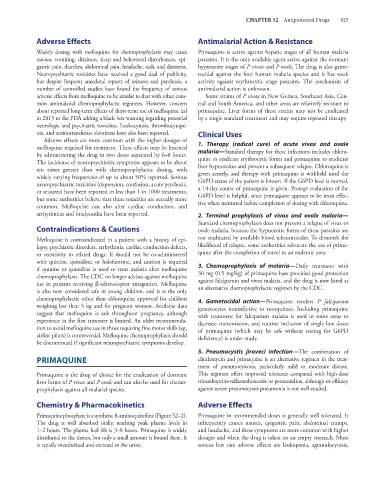Page 939 - Basic _ Clinical Pharmacology ( PDFDrive )
P. 939
CHAPTER 52 Antiprotozoal Drugs 925
Adverse Effects Antimalarial Action & Resistance
Weekly dosing with mefloquine for chemoprophylaxis may cause Primaquine is active against hepatic stages of all human malaria
nausea, vomiting, dizziness, sleep and behavioral disturbances, epi- parasites. It is the only available agent active against the dormant
gastric pain, diarrhea, abdominal pain, headache, rash, and dizziness. hypnozoite stages of P vivax and P ovale. The drug is also game-
Neuropsychiatric toxicities have received a good deal of publicity, tocidal against the four human malaria species and it has weak
but despite frequent anecdotal reports of seizures and psychosis, a activity against erythrocytic stage parasites. The mechanism of
number of controlled studies have found the frequency of serious antimalarial action is unknown.
adverse effects from mefloquine to be similar to that with other com- Some strains of P vivax in New Guinea, Southeast Asia, Cen-
mon antimalarial chemoprophylactic regimens. However, concern tral and South America, and other areas are relatively resistant to
about reported long-term effects of short-term use of mefloquine led primaquine. Liver forms of these strains may not be eradicated
in 2013 to the FDA adding a black box warning regarding potential by a single standard treatment and may require repeated therapy.
neurologic and psychiatric toxicities. Leukocytosis, thrombocytope-
nia, and aminotransferase elevations have also been reported. Clinical Uses
Adverse effects are more common with the higher dosages of
mefloquine required for treatment. These effects may be lessened 1. Therapy (radical cure) of acute vivax and ovale
malaria—Standard therapy for these infections includes chloro-
by administering the drug in two doses separated by 6–8 hours. quine to eradicate erythrocytic forms and primaquine to eradicate
The incidence of neuropsychiatric symptoms appears to be about liver hypnozoites and prevent a subsequent relapse. Chloroquine is
ten times greater than with chemoprophylactic dosing, with given acutely, and therapy with primaquine is withheld until the
widely varying frequencies of up to about 50% reported. Serious G6PD status of the patient is known. If the G6PD level is normal,
neuropsychiatric toxicities (depression, confusion, acute psychosis, a 14-day course of primaquine is given. Prompt evaluation of the
or seizures) have been reported in less than 1 in 1000 treatments, G6PD level is helpful, since primaquine appears to be most effec-
but some authorities believe that these toxicities are actually more tive when instituted before completion of dosing with chloroquine.
common. Mefloquine can also alter cardiac conduction, and
arrhythmias and bradycardia have been reported. 2. Terminal prophylaxis of vivax and ovale malaria—
Standard chemoprophylaxis does not prevent a relapse of vivax or
Contraindications & Cautions ovale malaria, because the hypnozoite forms of these parasites are
Mefloquine is contraindicated in a patient with a history of epi- not eradicated by available blood schizonticides. To diminish the
lepsy, psychiatric disorders, arrhythmia, cardiac conduction defects, likelihood of relapse, some authorities advocate the use of prima-
or sensitivity to related drugs. It should not be co-administered quine after the completion of travel to an endemic area.
with quinine, quinidine, or halofantrine, and caution is required
if quinine or quinidine is used to treat malaria after mefloquine 3. Chemoprophylaxis of malaria—Daily treatment with
chemoprophylaxis. The CDC no longer advises against mefloquine 30 mg (0.5 mg/kg) of primaquine base provided good protection
use in patients receiving β-adrenoceptor antagonists. Mefloquine against falciparum and vivax malaria, and the drug is now listed as
is also now considered safe in young children, and it is the only an alternative chemoprophylactic regimen by the CDC.
chemoprophylactic other than chloroquine approved for children 4. Gametocidal action—Primaquine renders P falciparum
weighing less than 5 kg and for pregnant women. Available data gametocytes noninfective to mosquitoes. Including primaquine
suggest that mefloquine is safe throughout pregnancy, although with treatment for falciparum malaria is used in some areas to
experience in the first trimester is limited. An older recommenda- decrease transmission, and routine inclusion of single low doses
tion to avoid mefloquine use in those requiring fine motor skills (eg, of primaquine (which may be safe without testing for G6PD
airline pilots) is controversial. Mefloquine chemoprophylaxis should deficiency) is under study.
be discontinued if significant neuropsychiatric symptoms develop.
5. Pneumocystis jiroveci infection—The combination of
PRIMAQUINE clindamycin and primaquine is an alternative regimen in the treat-
ment of pneumocystosis, particularly mild to moderate disease.
Primaquine is the drug of choice for the eradication of dormant This regimen offers improved tolerance compared with high-dose
liver forms of P vivax and P ovale and can also be used for chemo- trimethoprim-sulfamethoxazole or pentamidine, although its efficacy
prophylaxis against all malarial species. against severe pneumocystis pneumonia is not well studied.
Chemistry & Pharmacokinetics Adverse Effects
Primaquine phosphate is a synthetic 8-aminoquinoline (Figure 52–2). Primaquine in recommended doses is generally well tolerated. It
The drug is well absorbed orally, reaching peak plasma levels in infrequently causes nausea, epigastric pain, abdominal cramps,
1–2 hours. The plasma half-life is 3–8 hours. Primaquine is widely and headache, and these symptoms are more common with higher
distributed to the tissues, but only a small amount is bound there. It dosages and when the drug is taken on an empty stomach. More
is rapidly metabolized and excreted in the urine. serious but rare adverse effects are leukopenia, agranulocytosis,

